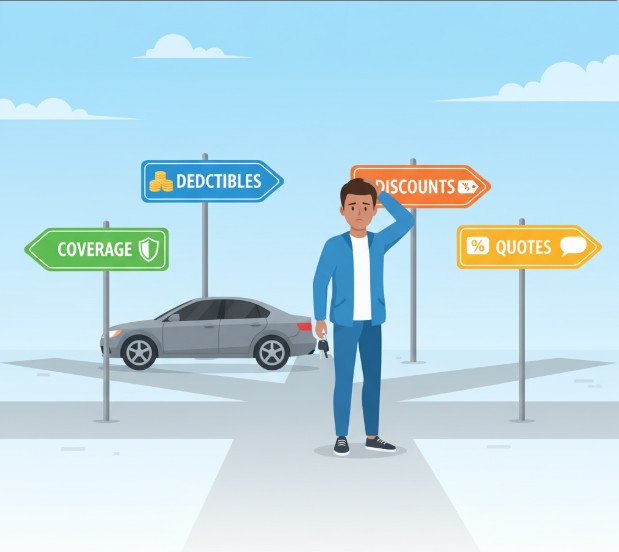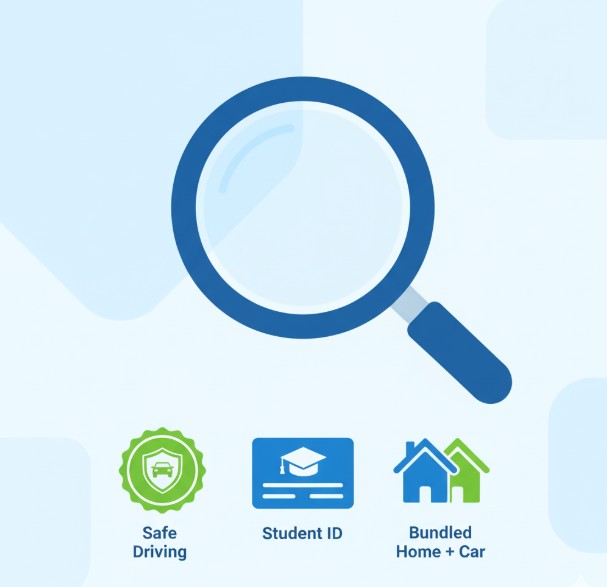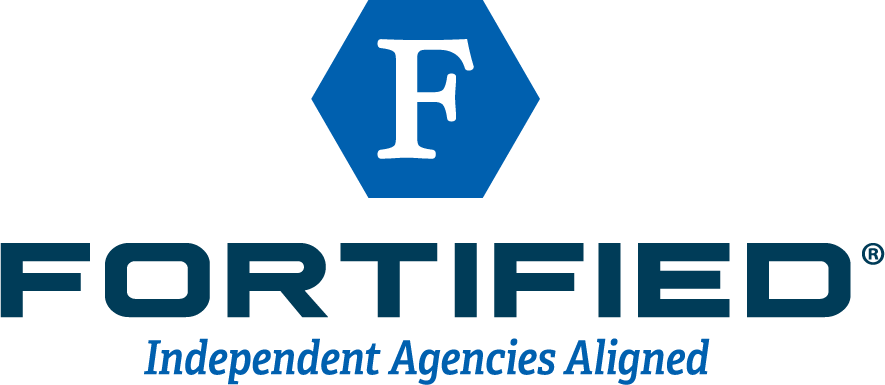

Choosing the right car insurance can feel like a maze—full of wrong turns and costly mistakes.
The most common mistakes when buying auto insurance include choosing only minimum coverage, ignoring discounts, failing to compare quotes, and misunderstanding policy details.
Avoiding these pitfalls ensures better protection, fair pricing, and fewer financial surprises after an accident.
Smart buyers balance value, coverage limits, and deductibles with their budget.
Auto insurance is a necessary expense for car owners, but it doesn’t have to be a financial burden.
By becoming aware of common errors, you can take proactive steps to secure a policy that suits your needs.
This guide will highlight key mistakes to avoid, helping you make informed choices when buying auto insurance.
Key Takeaways
- Avoiding common mistakes in auto insurance can save you money and stress.
- Always compare quotes, ask for discounts, and review policies yearly.
- Balance coverage limits and deductibles with your budget and assets.
- Never rely only on minimum coverage—it often leaves costly gaps.
- Consider all drivers on the policy, including high-risk drivers, to prevent surprises.
1) Choosing the Minimum Coverage

Relying only on state minimum coverage often leaves you exposed. Liability insurance covers others’ damages but not your own costs. Without comprehensive coverage, you pay out-of-pocket for repairs, theft, or natural disasters.
Some drivers opt for the minimum coverage required by law. This can be risky, as minimum coverage often doesn’t cover all potential costs after an accident.
The legal minimum may only include liability coverage. Liability coverage pays for damage and injuries you cause to others, but won’t pay for your costs.
Medical bills and repair costs can be very high. You might pay a lot out of pocket if you only have minimum coverage.
Adding comprehensive and collision coverage can provide better protection. These cover damages to your vehicle and incidents like theft or natural disasters.
Collision coverage pays for repairs after an accident, regardless of who is at fault. Meanwhile, comprehensive coverage covers non-collision-related damage.
You may also have to cover rental car fees after an accident without additional insurance. It’s essential to consider all potential expenses when selecting your insurance.
Don’t settle for less! Upgrade your coverage with Woodall & Hoggle and drive with assurance. Click here to explore our comprehensive and collision coverage options.
If you’re ready to get started, call us now!
2) Ignoring Discounts

Drivers often overlook potential discounts on their auto insurance. Insurance companies offer a variety of discounts that can significantly reduce premiums.
For example, enrolling in automatic payments can lead to savings. Insurance providers prefer timely payments.
Also, discounts might be available for bundling policies. Combining auto and home insurance with the same company often results in a lower rate.
Safe driving programs are another avenue for discounts. Many insurers reward drivers with clean records or who participate in safe driving courses.
Students with good grades may also qualify for lower rates. Some insurers offer discounts to young drivers who excel academically.
Moreover, memberships in certain organizations can reduce costs. Affiliations with groups like alumni associations or professional organizations may qualify for discounts.
Comparing different insurers is crucial to finding available discounts. Each company may offer unique savings opportunities.
Save more on your policy! Explore our various discounts at Woodall & Hoggle, including safe driving and multi-policy savings. Start saving today by clicking here!
If you’re ready to get started, call us now!
3) Failing to Compare Quotes

Many people fail to compare quotes from different insurance providers, which can result in financial losses.
Insurance rates can vary widely between companies. By not shopping around, individuals may miss out on more affordable options.
Experts recommend obtaining quotes from at least three different insurers. This helps to identify the best rates and coverage for their needs.
Various websites make it easy to compare quotes. These tools can simplify the process and save time and money.
It’s essential to look beyond the price. Comparing policy details, such as coverage limits and deductibles, is just as crucial.
4) Overlooking Deductibles

One common mistake many people make when buying auto insurance is overlooking deductibles. The deductible is the amount you must pay out of pocket before your insurance kicks in.
Choosing the right deductible is crucial for balancing your premium costs and potential out-of-pocket expenses.
A higher deductible usually means lower monthly premiums. This can save you money if you don’t expect to make many claims. However, it’s essential to have sufficient savings to cover the deductible in the event of an accident.
On the other hand, a lower deductible results in higher premiums, but you’ll pay less out of pocket when making a claim. This option may be more suitable for individuals who frequently file claims or prefer more predictable expenses.
Many people fail to consider how much they can afford to pay upfront in case of an accident. Evaluating your financial situation and choosing a deductible that aligns with your budget is essential.
Before finalizing your policy, carefully review the deductible options. This can prevent financial strain and ensure you are adequately protected in the event of an accident.
5) Not Asking About Bundling
Many people forget to ask their insurance provider about bundling options. Bundling can save money by combining different insurance policies, like home and auto, under one company.
It simplifies your billing process, as you receive a single bill for both policies. Additionally, insurance companies often offer discounts for bundling, which can help reduce your total premium.
Some people assume bundling isn’t worth the effort. However, those savings can add up over time. It’s always a good idea to ask your insurance agent if they offer bundling discounts.
Consider all the various types of insurance you have. You might have a home, renters, or even life insurance.
Ask your provider if you can bundle your auto insurance with them. You may be surprised to find significant savings and benefits.
6) Skipping Regular Policy Reviews
Failing to conduct regular reviews of your auto insurance policy can result in outdated coverage.
Policies and personal circumstances change, and what was sufficient a year ago may no longer be enough. Regularly checking your policy helps ensure it meets your current needs.
One common issue with not reviewing your policy is missing out on potential discounts.
Insurance companies often update their offerings, and you might qualify for new discounts or better rates that were not available when you first purchased your policy.
Additionally, you may need to adjust coverage requirements. States can change their minimum insurance requirements, or you might have new assets or liabilities that must be covered. Regular reviews help you stay compliant and adequately protected.
Neglecting policy reviews can also result in errors not being caught. Mistakes can happen, and you may be paying for coverage you don’t need or missing coverage you do. Regularly reviewing your policy lets you correct these errors promptly.
Lastly, it’s easy to overlook the benefits of policy bundling. Reviewing your policies might reveal opportunities to bundle home, auto, and other insurances for better rates and benefits.
Regular reviews ensure your policy remains optimal for your needs and circumstances.
7) Misunderstanding Coverage Limits
Many people misunderstand their auto insurance coverage limits. They often think the minimum state requirements will fully protect them. This mistake can lead to significant financial strain after an accident.
State minimums usually cover only a portion of accident costs. For example, bodily injury liability only covers $25,000 per person. If medical bills exceed this amount, the driver pays the difference out of pocket.
It’s essential to understand each coverage type. Liability coverage pays for damages to others, not for your car or injuries.
Meanwhile, comprehensive and collision coverage protects your vehicle in various situations, such as theft or accidents.
Under-insuring is a common problem. Drivers should consider their assets and choose coverage limits that protect those assets.
Consulting multiple insurance providers and getting detailed quotes can help you understand these limits better.
Not all policies are the same. Drivers need to carefully review and understand their policy details before making decisions. This helps avoid unexpected costs and legal issues down the road.
If you’re ready to get started, call us now!
8) Not Considering High-risk Drivers
When buying auto insurance, it’s important to consider high-risk drivers. High-risk drivers are those who have a history of accidents or traffic violations. Insurers view these drivers as more likely to file claims, which can result in higher premiums.
Ignoring the possibility of high-risk drivers in your household can be costly. If someone in your family fits this profile, your insurance rate could increase. Evaluating everyone the policy will cover helps avoid surprises.
It’s essential to understand what options are available for high-risk drivers. Special policies, known as high-risk auto insurance, can provide necessary coverage. Research any additional requirements or higher costs involved.
Shopping around can also make a difference. Different insurers take various approaches to high-risk drivers. Comparing quotes can help you find a more affordable rate.
Ultimately, many insurers offer programs to help high-risk drivers improve their driving records. Defensive driving courses or safe driving programs might lower premiums over time.
Considering these factors ensures comprehensive and cost-effective coverage for all policyholders.
Auto Insurance Mistakes Comparison Table
| Mistake | Consequence | How to Avoid |
| Choosing only the minimum coverage | Major out-of-pocket costs after accidents, theft, or disasters | Add collision + comprehensive; raise liability limits |
| Ignoring discounts | Higher premiums than necessary | Ask about bundling, safe driver, student, autopay, and membership discounts |
| Failing to compare quotes | Overpaying for the same coverage | Get at least three quotes; compare coverage details, not just price |
| Overlooking deductibles | Financial strain or unnecessarily high premiums | Choose a deductible that matches your budget and risk tolerance |
| Not asking about bundling | Missed multi-policy savings | Combine home, renters, or life insurance with auto for lower rates |
| Skipping regular policy reviews | Outdated coverage, missed savings, and compliance issues | Review policies annually; update coverage for life changes |
| Misunderstanding coverage limits | Liability exposure beyond state minimums | Choose coverage that matches your income, assets, and real risks |
| Not considering high-risk drivers | Surprise premium increases | Disclose all drivers; explore defensive driving programs or specialty policies |
Understanding Auto Insurance Policies

Auto insurance policies typically include liability, collision, comprehensive, personal injury protection, and uninsured motorist coverage.
Understanding these options, along with policy limits and deductibles, helps you choose adequate protection without overspending. Always balance your budget with realistic risk scenarios.
Types of Coverage
Auto insurance typically includes several types of coverage. Liability coverage is mandatory in most states and covers damages to others if you’re at fault in an accident.
Collision coverage pays for damage to your vehicle from a collision with another car or object.
Comprehensive coverage protects against non-collision-related damages, including theft, vandalism, or natural disasters.
Meanwhile, personal injury protection (PIP) covers medical expenses for you and your passengers, regardless of fault.
Lastly, uninsured/underinsured motorist coverage protects you if a driver with insufficient insurance hits you.
Each type of coverage serves a specific purpose. It’s crucial to choose the right combination to protect yourself financially.
Policy Limits and Deductibles
Policy limits define the maximum amount your insurer will pay for a covered claim. There are limits per person and accident for bodily injury and property damage.
Higher limits offer more protection but come with higher premiums. It’s vital to assess your needs and select adequate coverage limits.
Deductibles are the amounts you pay out of pocket before insurance kicks in. Higher deductibles usually mean lower premiums, and vice versa.
Choosing the right deductible depends on your financial situation and risk tolerance.
Balancing deductibles with policy limits helps manage costs while ensuring sufficient protection.
Auto Insurance Mistakes Checklist
Do’s (Smart Moves):
- Compare quotes from at least three insurers before buying.
- Review your policy annually to stay updated and compliant.
- Ask about every available discount (safe driving, bundling, student, autopay).
- Choose coverage limits that reflect your assets and risk, not just the legal minimum.
- Match your deductible to your savings and comfort level.
- Evaluate all household drivers, including high-risk ones.
- Bundle home, renters, or life insurance when possible for savings.
Don’ts (Common Pitfalls):
- Don’t buy insurance based on price alone—value and coverage matter more.
- Don’t rely only on state minimum liability coverage.
- Don’t skip reading policy exclusions and fine print.
- Don’t let your coverage lapse or delay claim reporting.
- Don’t assume your insurer will automatically apply discounts—you must ask.
Ready to secure your peace of mind on the road? Connect with Woodall & Hoggle today for personalized, cost-effective auto insurance tailored just for you. Make the smart choice—get covered now!
Contact Us Today For An Appointment
Frequently Asked Questions
What factors affect the cost of auto insurance premiums?
Premiums are influenced by several factors, including your age, driving history, location, type of vehicle, annual mileage, and the coverage you select. Credit score and household drivers also impact rates. Comparing quotes helps find the best price for your situation.
Why is it important to read the fine print in an auto insurance policy?
Reading policy terms ensures you understand exclusions, limits, and conditions. This prevents claim denials and unexpected costs later. Skimming or ignoring the fine print is a common mistake that leaves drivers underinsured.
How often should you review your auto insurance policy?
Review your policy at least once a year—or after significant life changes, such as buying a new car, moving, or adding a driver. Annual reviews help capture new discounts, adjust coverage, and avoid compliance issues.
Is the lowest premium always the best auto insurance option?
Not always. The cheapest policy often comes with reduced coverage limits and exclusions, leaving you exposed to high out-of-pocket costs. Balancing affordability with sufficient coverage provides real protection.
What’s the best way to compare auto insurance quotes?
Collect at least three quotes and review more than just the price. Compare coverage types, policy limits, deductibles, and the benefits included. Online comparison tools make this process faster and highlight differences between insurers.
How can high-risk drivers affect your auto insurance policy?
High-risk drivers—such as those with accidents or violations—increase premiums for everyone on the policy. Disclosing them upfront avoids surprises. Specialized coverage or defensive driving programs can reduce costs over time.
What steps help avoid overpaying for car insurance?
Shop around regularly, ask about all available discounts, bundle policies where possible, and review your coverage yearly. Adjust deductibles and limits to match your needs, not just state minimums.













